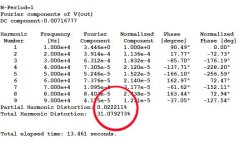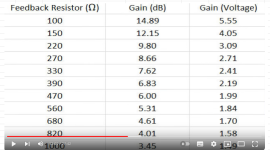Those 'stopper' resistors should remain low.Is it beneficial to increase R3 and R6 as well, to 560 like the schematic shows or other value? And would a better quality resistor make any improvement?
I think 100 ohms is best or even a bit lower. Increasing the value causes big problems in LT SPICE simulations.The stock circuit seems very stable. I don't see any reason to increase it.
Attachments
R3 and R6 to 560 using AD774 OpAmp will yield this result with a few volts out P-P into 600 ohm load from this preamp/lineamp.
Attachments
Last edited:
Off topic so disregard but I will say this about the Hafler DH101 Preamplifier.In a way it is a shame to gut this 101, but the clone sounds so damn good!
I loaded it into LT SPICE and stripped off the tone controls and experimented with the circuit in many ways.
The 101 circuit is fickle and component-sensitive beyond what is usually regarded baseline with today's standards.
The tone control is embedded into the preamp, upon removing it, I don't think the circuit could be considered a 101.
There is no loss in this universe without the DH101.
Regarding this MOFI preamp and the change of the 100uF caps near the regulators with 0.47uF film for the 7815 and 1uF for the 7915. The sound quality is dramatically improved, with increased clarity and depth of soundstage. That is until the input level gets too high, then there is clear distortion. The lack of power supply regulation creates a blurriness that is probably masking the distortion. This is with an otherwise stock MOFI with 100R feedback resistors. Fixed 100K resistors on the input. A max input voltage of only 0.235Vrms is distorting.
I am waiting for some CRDs to add @chalky mods. Plan a stepwise approach, with the VAS first.
I am waiting for some CRDs to add @chalky mods. Plan a stepwise approach, with the VAS first.
That is a shame and indicative of a problem in your board. 1st suspect is the OpAmp and 2nd would be the transistors and 3rd power supply rails or other...A max input voltage of only 0.235Vrms is distorting
Last edited:
I had my clone on the scope yesterday and I could see no clipping until over 3v rms output from the AWG. So I guess it is not clipping you are seeing.
Are you measuring distortion or just doing listening test?
I am very tempted to grab an Analog Discovery. I have an older OTL tube amp, an older SS Class A amp, will soon be building a pair of mono ACA amps, and two clone Grounded Grid tube amps (not to mention 4 SONY reel to reels I am working on) so I guess it would come in very handy...
Are you measuring distortion or just doing listening test?
I am very tempted to grab an Analog Discovery. I have an older OTL tube amp, an older SS Class A amp, will soon be building a pair of mono ACA amps, and two clone Grounded Grid tube amps (not to mention 4 SONY reel to reels I am working on) so I guess it would come in very handy...
May I suggest a 'regular' $500 digital scope and a $600 QA403 analyzer? Cheers.I am very tempted to grab an Analog Discovery.
...and a ~$500-ish signal generator.
[[There is no loss in this universe without the DH101.]]
I was waffling a bit about that surgery but now I am not 😉 thank you.
And I sure noticed a difference after listening to both for about 4 hours back to back yesterday, The accuphase clone just sounds more dynamic, smoother and more "in the room" in the vocals, and way sweeter in the highs (sorry for the goofy descriptions but we just do not have natural language available to describe audio precisely). I had to use that tone control on the 101 to reduce the treble response, couldn't take the grit after about 1/2 hour,
I was waffling a bit about that surgery but now I am not 😉 thank you.
And I sure noticed a difference after listening to both for about 4 hours back to back yesterday, The accuphase clone just sounds more dynamic, smoother and more "in the room" in the vocals, and way sweeter in the highs (sorry for the goofy descriptions but we just do not have natural language available to describe audio precisely). I had to use that tone control on the 101 to reduce the treble response, couldn't take the grit after about 1/2 hour,
If you are going down that road, stop in at the heat sink store nearest you and get some coolers for your transistors.I am waiting for some CRDs to add @chalky mods.
It may be in your best interest.
Cheers
The final 'output' transistors Q6 & Q12 are an excellent upgrade path if you want to drive complex loads 600 ohms and lower...headphones.
The SS8050/SS8550 and or ZTX951/ZTX851 reside in this design well. I have even simulated those transistors closer to the front in the Q10 Q4 locations.
The whole thing starts to behave like a 'real' piece of audio gear when the more powerful transistors get put into the hot spots to do the heavy lifting.
The measurements in spice become closer to what I would expect in reality with these more robust substitutions in place.
The SS8050/SS8550 and or ZTX951/ZTX851 reside in this design well. I have even simulated those transistors closer to the front in the Q10 Q4 locations.
The whole thing starts to behave like a 'real' piece of audio gear when the more powerful transistors get put into the hot spots to do the heavy lifting.
The measurements in spice become closer to what I would expect in reality with these more robust substitutions in place.
No, we're doing fine. We are allowed to share some musings, yes. 👍@STOXX. . Yeah we may be getting somewhat off topic. I don't want to annoy anyone here that's for sure...
Also, the final transistor pair may benefit from an even higher bias or larger CRD diode if those transistors have heat sinks and are beefed up to take it.E-352 is the part number, 3.50mA.
Pair this with emitter resistor reduction and reduce the final series output resistor to .5 ohms and raise the rail voltage.
Driving this thing into a different arena looks relatively straightforward and possibly highly beneficial if you are willing to walk away from YouTube Beeney's ultra low distortion discovery. Personally. I get nervous around 0.00001% distortion readings. I like real world stuff like 0.05%. But that is just the way my old-man-self is.
I've questioned the validity of the C-3850 clone board from China ever since I held it in my hand. I bought two of them from AliExpress.Would just an LME49720 and LME49600 preamp be simpler and the same or better performance?
My 1st reaction was tearing the OpAmp right off the front, cranking up the circuit into Class A. The 'stale' OpAmp on the front is superfluous to the Class A desire from the discrete section and the on-board schematic as it is, has no true Class A to even speak of in the first place. I find it hard to believe the designer of this circuit board in China has any clue what the original circuit in the C-3850 was. This board generates more questions than answers.
Leaving the 'bastard' OpAmp in place yields the circuit to more fun and can easily be bypassed. So I say, leave it there. It's orriginal purpose may have been to receive a balanced input. Then it would have a true purpose here.
I don't really know anything. I still have not populated one of these circuit boards. I think I am getting closer each day to actually doing so BUT I may just wait for the brilliantly suggested current diodes to show up from China.
- Home
- Amplifiers
- Solid State
- Clon C-3850



